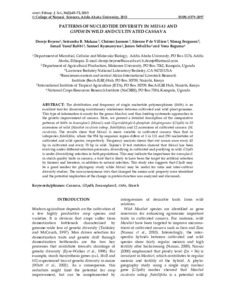| dc.contributor.author | Beyene, D. |
| dc.contributor.author | Mukasa, S.B. |
| dc.contributor.author | Jansson, C. |
| dc.contributor.author | Villiers, Etienne P. de |
| dc.contributor.author | Ferguson, M. |
| dc.contributor.author | Rabbi, Ismail Y |
| dc.contributor.author | Kyamanywa, S. |
| dc.contributor.author | Sebuliba, J. |
| dc.contributor.author | Baguma, Yona K. |
| dc.date.accessioned | 2019-12-04T11:04:16Z |
| dc.date.available | 2019-12-04T11:04:16Z |
| dc.date.issued | 2013 |
| dc.identifier.citation | Beyene, D., Mukasa, S.B., Jansson, C., de Villiers, E., Ferguson, M., Rabbi, I.Y., ... & Baguma, Y. (2013). Patterns of nucleotide diversity in Meisa1 and G3pdh in wild and cultivated cassava. SINET: Ethiopian Journal of Science, 36(2), 65-72. |
| dc.identifier.issn | 0379-2897 |
| dc.identifier.uri | https://hdl.handle.net/20.500.12478/1385 |
| dc.description.abstract | The distribution and frequency of single nucleotide polymorphisms (SNPs) is an excellent tool for discerning evolutionary relatedness between cultivated and wild plant genomes. This type of information is scanty for the genus Manihot, and thus limiting systematic approaches in the genetic improvement of cassava. Here, we present a detailed description of the comparative patterns of SNPs in Isoamylase1 (Meisa1) and Glyceraldehyde-3-phosphate dehydrogenase (G3pdh) in 10 accessions of wild (Manihot esculenta subsp. flabellifolia) and 12 accessions of cultivated cassava (M. esculenta). The results show that Meisa1 is more variable in cultivated cassava than that in subspecies flabellifolia, where the 954 bp sequence region differs at 1 in 111 and 250 nucleotides of cultivated and wild species, respectively. Frequency analysis shows that SNP occurs once every 42 bp in cultivated and every 70 bp in wild. Tajima’s D test statistics showed that Meisa1 has been evolving under different selection pressures, diversifying in cultivated and purifying in wild. G3pdh is under diversifying selection in both populations. This may indicate the importance for isoamylase1 in starch quality traits in cassava, a trait that is likely to have been the target for artificial selection by farmers and breeders, in addition to natural selection. This study also suggests that G3pdh may be a good marker for phylogeny study while Meisa1 may be useful for intra and inter-cultivar diversity studies. The non-synonymous SNPs that changed the amino acid property were identified and the potential implication of the change in protein function was analyzed and discussed. |
| dc.description.sponsorship | Swedish International Development Cooperation Agency |
| dc.format.extent | 65-72 |
| dc.language.iso | en |
| dc.subject | Cassava |
| dc.subject | Starch |
| dc.subject | Genetic Improvement |
| dc.subject | Hybrids |
| dc.subject | Genotypes |
| dc.subject | Enzymes |
| dc.subject | Isoamylase |
| dc.subject | Nucleotides |
| dc.title | Patterns on nucleotide diversity in Meisa1 and G3PHD in wild and cultivated cassava |
| dc.type | Journal Article |
| dc.description.version | Peer Review |
| cg.contributor.crp | Roots, Tubers and Bananas |
| cg.contributor.affiliation | Addis Ababa University |
| cg.contributor.affiliation | Makerere University |
| cg.contributor.affiliation | International Livestock Research Institute |
| cg.contributor.affiliation | International Institute of Tropical Agriculture |
| cg.contributor.affiliation | National Crops Resources Research Institute, Uganda |
| cg.coverage.region | Africa |
| cg.coverage.region | West Africa |
| cg.coverage.region | East Africa |
| cg.coverage.country | Nigeria |
| cg.coverage.country | Rwanda |
| cg.coverage.country | Uganda |
| cg.coverage.country | Kenya |
| cg.authorship.types | CGIAR and developing country institute |
| cg.iitasubject | Cassava |
| cg.iitasubject | Genetic Improvement |
| cg.journal | Ethiopian Journal of Science |
| cg.howpublished | Formally Published |
| cg.accessibilitystatus | Limited Access |
| local.dspaceid | 79526 |

